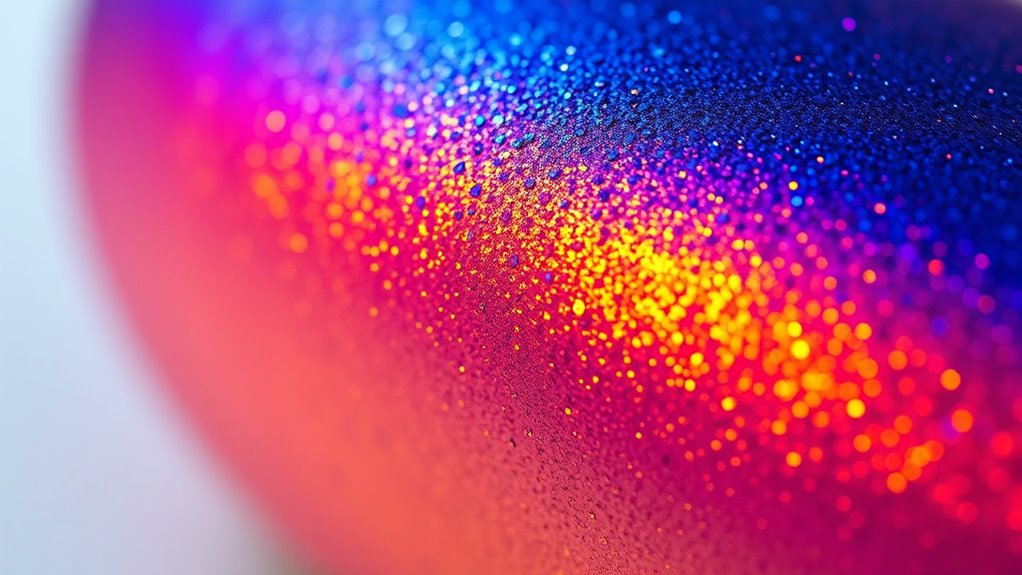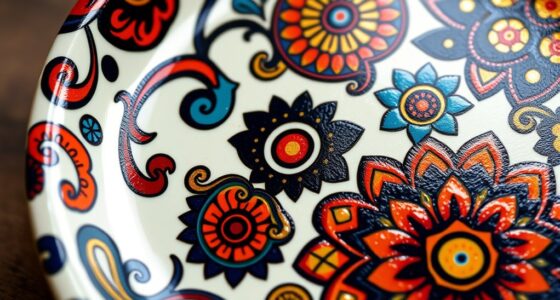Discover the magic of color-changing crafts using thermochromic and solar-reactive materials. These innovative pigments respond to heat or sunlight, transforming your projects into dynamic art pieces. You can create clothing, decor, or interactive displays that shift hues with temperature changes or sunlight exposure. By understanding how to work with these materials safely and effectively, you’ll reveal endless creative possibilities. Keep exploring to learn more about crafting with these captivating responsive effects.
Key Takeaways
- Thermochromic and solar-reactive materials change color in response to temperature or sunlight, creating dynamic visual effects in crafts.
- Proper storage, testing, and handling ensure durability and consistent color shifts in temperature- and sun-sensitive crafts.
- Using specialized tools like brushes, stencils, and heat sources enhances control and creativity in color-changing projects.
- Environmental considerations include selecting eco-friendly pigments and responsible disposal to minimize ecological impact.
- Incorporating scientific principles like chemical reactions and temperature effects enriches understanding and effectiveness of these craft techniques.
Exploring Thermochromic Materials and Their Uses

Thermochromic materials change color in response to temperature changes, making them fascinating for various applications. Historically, these materials have been used in mood rings and thermometers, demonstrating their early significance. Today, they’re found in novelty items, clothing, and even packaging, adding interactive and educational value. When considering environmental impacts, thermochromic materials raise questions about sustainability and their ecological footprint. Some contain chemicals that can be toxic or difficult to recycle, prompting researchers to develop eco-friendly options. Their ability to visually indicate temperature shifts offers benefits like energy savings and safety alerts, but responsible disposal remains essential. Additionally, advancements in AI-powered sustainability solutions are helping to create eco-friendly thermochromic materials that reduce environmental impact. Incorporating sustainable materials into thermochromic products can further lessen their ecological footprint and promote responsible consumption. Moreover, ongoing research into chemical safety aims to mitigate potential health risks associated with certain thermochromic compounds. Understanding the performance characteristics of these materials is crucial for optimizing their durability and effectiveness in various conditions.
How Solar-Activated Pigments Transform Under Sunlight
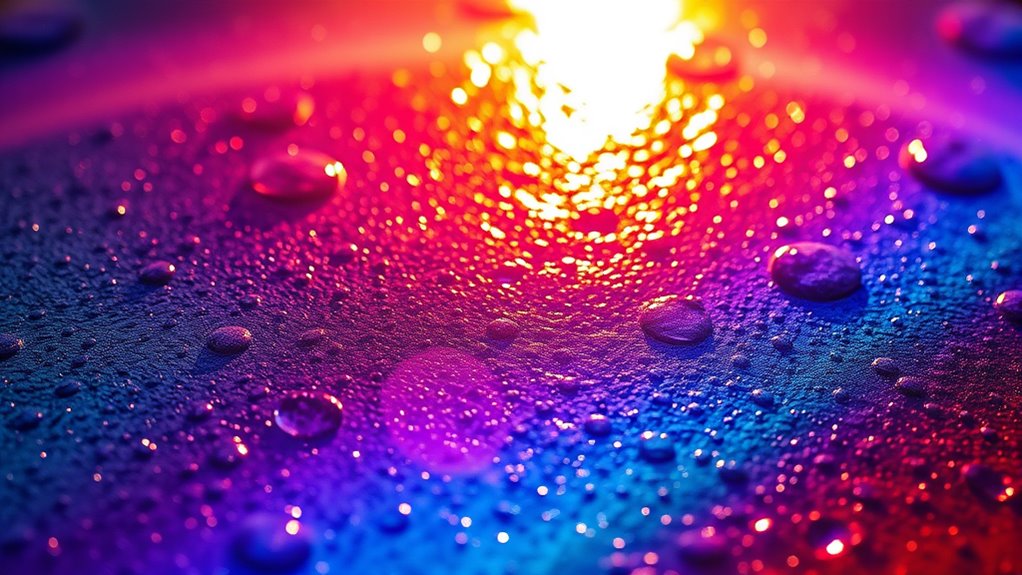
When sunlight hits solar-activated pigments, they change color instantly, revealing a new hue. This happens because the pigments react chemically to the light, altering their structure. As the temperature shifts under the sun, it further influences their appearance, making your crafts truly dynamic. Additionally, understanding the market trends in specialty and artisanal teas can inspire eco-friendly and innovative craft projects aligned with sustainable practices. Incorporating elements of rustic decor into your projects can enhance their farmhouse-inspired aesthetic and appeal. Being mindful of environmental considerations ensures your creative process remains eco-conscious and sustainable.
Sunlight Triggers Color Shift
Sunlight acts as a powerful trigger for certain color-changing crafts, causing solar-activated pigments to shift hues instantly. Historically, these pigments have been used in decorative items, textiles, and even safety signs, allowing for visual cues that react to sunlight. When exposed, the pigments absorb solar energy, prompting a rapid change in color. This natural response makes them especially appealing for outdoor art and wearable designs. Looking ahead, future innovations aim to improve the durability, sensitivity, and range of color shifts, expanding their applications. Researchers are exploring new materials that respond more vividly and last longer under prolonged sun exposure. As technology advances, sunlight will continue to serve as a reliable, eco-friendly catalyst, unleashing exciting possibilities for dynamic, solar-reactive crafts.
Pigments React Chemically
Solar-activated pigments change color through a chemical reaction triggered by exposure to sunlight. When sunlight hits these pigments, it initiates a chemical change that alters their structure, resulting in a color shift. The process depends on the pigment’s stability, which determines how well it resists fading or degradation over time. Understanding these chemical reactions helps you choose durable, long-lasting materials for your crafts. Here’s a quick overview:
| Reaction Type | Effect on Pigments | Importance |
|---|---|---|
| Oxidation | Alters color stability | Reduces longevity |
| Photoreduction | Reverses color change | Enables reusability |
| Isomerization | Changes dye structure | Affects color intensity |
Knowing how these reactions work helps you create vibrant, resilient solar-reactive projects.
Temperature Alters Appearance
Temperature plays a crucial role in how solar-activated pigments change color, as heat can influence the speed and intensity of their transformations. When exposed to sunlight, thermochromic ink and solar reactive paint respond by shifting hues, revealing vibrant or subtle changes. As the temperature rises, these materials activate more quickly, deepening or altering their colors. Conversely, cooler conditions slow down or reverse the effect. This temperature-dependent behavior allows for dynamic crafts that change appearance throughout the day. By understanding how heat affects these pigments, you can create projects that visually respond to sunlight and temperature fluctuations. Whether designing wearables or decorative items, controlling temperature influences how vividly and rapidly your thermochromic ink and solar reactive paint transform.
Creative Projects With Color-Change Techniques
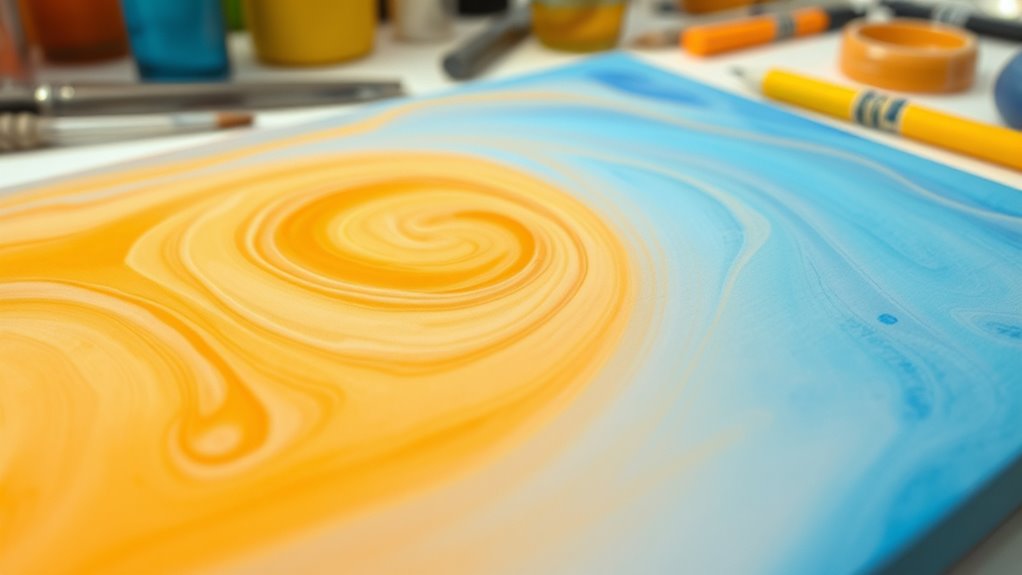
Creative projects that incorporate color-change techniques open up exciting possibilities for both beginners and experienced crafters. You can experiment with thermo sensitive fabrics to create apparel that shifts color with body heat, adding a fun, interactive element to clothing. Solar reactive inks allow you to design artwork or accessories that change color when exposed to sunlight, making outdoor projects more dynamic. These techniques are versatile and easy to incorporate into various crafts like custom t-shirts, bags, or home decor. By blending these materials into your projects, you’ll produce eye-catching pieces that surprise and delight. Whether you’re making personalized gifts or decorative items, using heat-sensitive fabrics and solar reactive inks elevates your craft game with vibrant, innovative effects.
Tools and Supplies for Color-Shifting Crafts

To successfully create color-shifting crafts, you’ll need a variety of specialized tools and supplies that make working with these innovative materials straightforward. Essential items include thermochromic paints, solar-reactive inks, and brushes designed for detailed color blending, allowing you to achieve smooth transitions and vibrant effects. A heat source like a heat gun or warm water helps activate temperature-sensitive colors. Additionally, stencils and masking tape enable precision, fostering artistic expression. Having a palette for mixing colors and a palette knife enhances your ability to customize hues and textures. The right tools empower you to explore dynamic color transformations and bring your creative visions to life. Incorporating color-changing effects into your craft projects can also add an extra layer of creativity, especially when using materials that mimic natural tones and textures. Using specialized tools designed for thermochromic and solar-reactive materials ensures better control and more impressive results, similar to how auto tuning optimizes vehicle performance for better handling. Exploring indoor gardening options like unique planters can inspire innovative designs that complement your craft projects and surroundings.
Tips for Working With Temperature-Responsive Materials
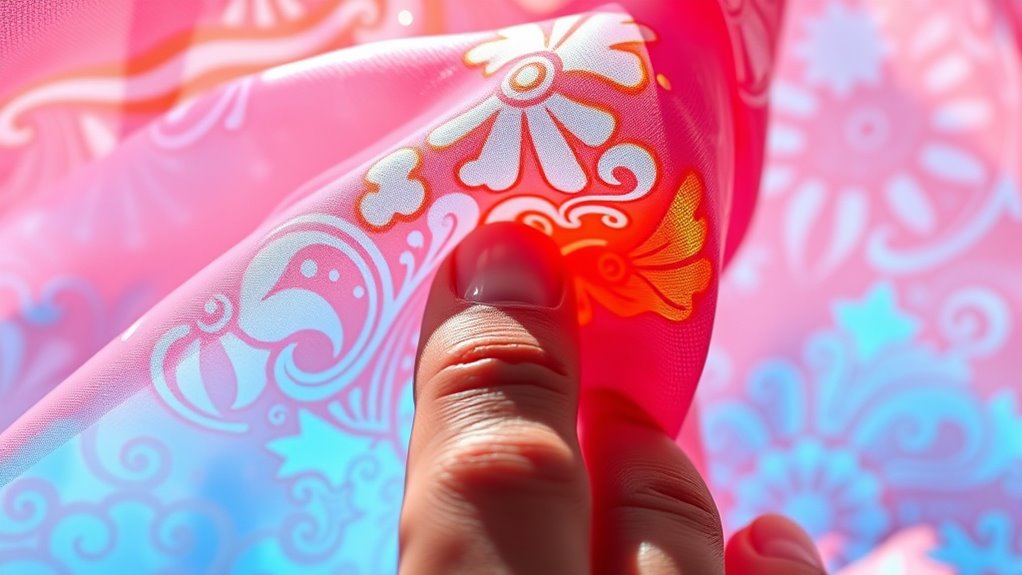
Working with temperature-responsive materials requires careful attention to detail to achieve the desired color changes. To maintain color stability, store your materials in a cool, dry place away from direct sunlight, which can cause premature fading or unwanted color shifts. When working with these materials, avoid exposing them to extreme temperatures outside their specified range, as this can degrade their integrity and reduce material longevity. During application, test small samples first to ensure consistent color change and stability. Keep your workspace clean and free of contaminants that could affect the responsiveness. Proper handling and storage help conserve the vibrant color shifts and extend the lifespan of your materials, ensuring your projects look great and last longer. Additionally, understanding material properties is essential for successful thermochromic and solar-reactive craft projects. Regularly inspecting your materials for signs of deterioration can prevent unexpected failures. Choosing the right materials and staying informed about market growth projections can help you choose the most advanced and durable materials for your creative endeavors. Being aware of common causes of failure can also help you take preventative measures to ensure your materials perform reliably over time.
Safety Considerations and Best Practices

While handling temperature-responsive materials, safety should always come first to prevent accidents and guarantee successful projects. Handling chemical safety is vital, so always work in a well-ventilated area and wear protective gloves and goggles when necessary. Follow label instructions carefully, especially regarding mixing or applying chemicals. Proper storage best practices are essential; keep thermochromic and solar-reactive materials in labeled, airtight containers away from direct sunlight and extreme temperatures. Store chemicals out of reach of children and pets. Avoid contamination by cleaning tools thoroughly after use. Dispose of unused or expired materials according to local regulations. By prioritizing handling chemical safety and maintaining proper storage, you reduce risks and ensure your creative process remains safe and enjoyable.
Inspiring Ideas for Interactive and Dynamic Artworks
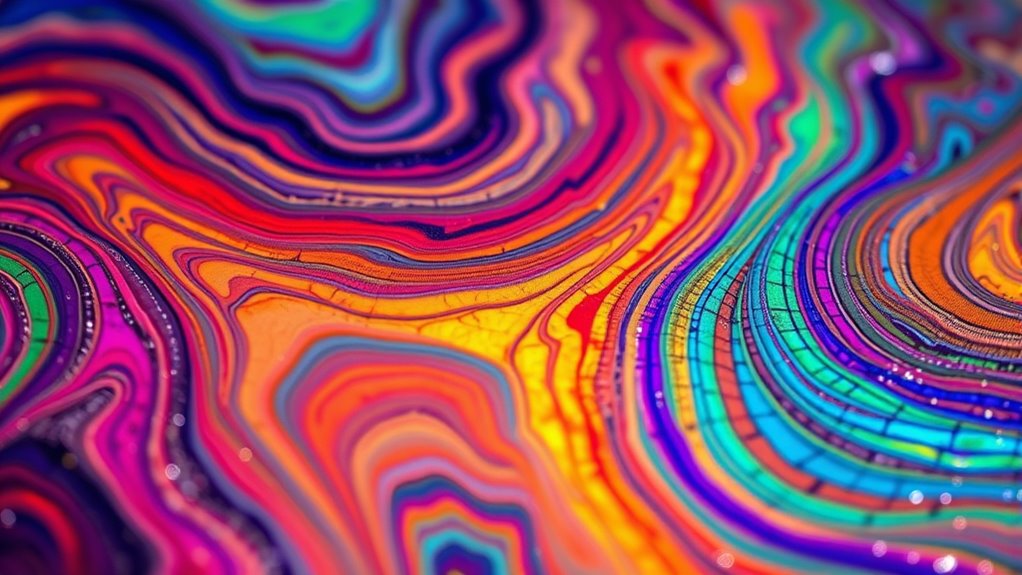
Interactive and dynamic artworks harness the unique properties of temperature-responsive materials to engage viewers in new and exciting ways. These creations draw on historical applications of thermochromic and solar-reactive paints, revealing how scientific principles influence art. By integrating these materials, you can craft pieces that change with temperature shifts or sunlight, offering an immersive experience. For example, a mural that reveals hidden images when heated or cooled, or a sculpture that responds to environmental conditions. Such artworks inspire curiosity and demonstrate the interplay of science and creativity. To elevate your projects, consider exploring:
- Historical uses of thermochromic dyes in fashion and design
- Scientific mechanisms behind color changes
- Techniques for integrating materials into mixed media art
- Interactive installations that educate about scientific principles
- Creative ways to incorporate solar-reactive elements for outdoor displays
Additionally, understanding the color-changing mechanisms behind these materials can help you optimize their use in your artwork. Exploring the financial aspects of sourcing and maintaining these materials can ensure your projects remain sustainable and cost-effective.
Frequently Asked Questions
How Long Do Thermochromic and Solar-Reactive Colors Last Before Fading?
You might wonder how long thermochromic and solar-reactive colors last before fading. Typically, their color retention depends on material longevity and how often you use or wash the item. Usually, these colors can last from several months to a couple of years with proper care. To extend their lifespan, avoid harsh chemicals and excessive heat, ensuring the materials stay vibrant and functional over time.
Can These Materials Be Used Outdoors in Harsh Weather Conditions?
You can use thermochromic and solar-reactive materials outdoors, but their UV stability impacts durability. Harsh weather can cause fading or damage over time, reducing material longevity. To guarantee longer-lasting effects, choose products specifically designed for outdoor use, with added UV protection. Regular maintenance and proper sealing can also help extend their lifespan, so your crafts stay vibrant even in tough weather conditions.
Are There Eco-Friendly or Non-Toxic Options Available for These Crafts?
Did you know that over 80% of craft enthusiasts prefer eco-friendly options? You’ll be glad to know there are eco-friendly dyes and non-toxic pigments available for your projects. These options are safe for the environment and your skin, making your crafts sustainable. You can confidently create vibrant, color-changing masterpieces knowing you’ve chosen non-toxic pigments that are both beautiful and eco-conscious, perfect for any outdoor or indoor project.
How Do Temperature Fluctuations Affect the Durability of Color Changes?
You might wonder how temperature fluctuations impact your crafts’ color changes. Rapid or extreme shifts can challenge temperature stability, causing the color to fade or become inconsistent over time. To guarantee material longevity, handle your projects within moderate temperature ranges and avoid prolonged exposure to harsh conditions. Maintaining stable temperatures helps preserve vibrant color changes and extends the lifespan of the thermochromic or solar-reactive materials.
Can These Materials Be Integrated Into Wearable or Clothing Projects?
You can definitely integrate thermochromic and solar-reactive materials into wearable projects. Just keep in mind that fabric durability might be affected over time, especially with frequent washing or friction. Comfort considerations are also important; choose lightweight, breathable fabrics so the color-changing effects don’t compromise wearability. Proper sealing and treatment can enhance durability, ensuring your creative clothing stays vibrant and functional through daily use.
Conclusion
So, next time you marvel at a color-changing craft, remember—it’s not just magic, but science at play. Ironically, these clever materials react so predictably to heat and sun that your “magical” art might just outsmart your expectations. Embrace the science behind the shimmer, and you’ll realize that the true magic lies in understanding how simple temperature shifts create stunning, dynamic masterpieces. After all, science makes the magic happen—who knew?
